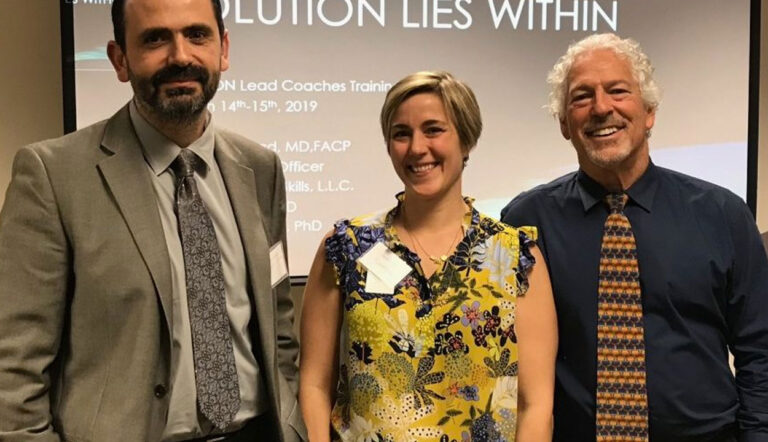Leadership, by all accounts, stands for an ability. This ability focuses on moving people or an organization towards a desired goal. As an ability, it is both innate and learned. This ability is shaped by the individual, his or her environment, the constant change and its demands, and the organization and tasks/responsibilities at hand. Over the past decade, there has been an increase in demand for physicians assuming leadership roles in organizations. These roles vary with a common focus of bridging the medical world with the business world. With the physician assuming a leadership/managerial role in the healthcare industry, several challenges and obstacles have surfaced. Most of these obstacles are found in the realm of the identity of physicians, the purpose of physicians, their training, their expectations, and their lack of know how.
The challenges of the organizations and physicians are:
- To be able to navigate the identity of physicians
- Maximize their training
- Influence their thought processes
- Develop their leadership skills
- Understand the new landscape of the profession and business of medicine.
More often than not, healthcare organizations and their success depend on physician involvement and participation. This has necessitated the development of the physician executive/manager/leader to help secure physician involvement (Guthrie, 1999). One of the main problems in this approach is that physicians get promoted based on their clinical expertise and success into roles that require a totally different set of abilities, desires and expertise (Quinn & Perelli, 2016). In 2015, Andersson described the differences between the physician clinician mind and the physician manager mind (Andersson, 2015). Some of the major differences lie in the physician as an autonomous entity in a system versus a manager as a subordinate in the same system. The psychological makeup of the physician will usually trigger him or her to act more as a physician than as a manager, even as the need or situation requires a manager mindset. Physicians sometimes described their role as managers as “belonging to the dark side” and voiced their struggle with maintaining their identity and purpose as physicians, and feeling that their managerial posts offered little or no benefit, sometimes describing it as a negative aspect of their lives (Kane & Cyr, 2018). Some of their impediments came straight from their peers as they were viewed with suspicion, experienced hostile attitudes towards them, and a sense of skepticism and disappointment. Further, there are inherent problems in managing physicians which were summarized as follows: Physicians have a high level of expertise and status; physicians often lack adequate knowledge of the system in which they work; and physicians usually do what they want in their institution (von Knorring M, de Rijk A, Alexanderson K, 2010). Physicians, during their training, emphasize their own individual performance, their own growth, and value their autonomy, and have a difficult time seeing themselves as “followers” with little value given to leaders within their own institution (Stoller, 2019). Stoller dives into more detail in analyzing the problems physicians might face as leaders in an organization. He states four aspects of physicians’ training that will hinder and work against their abilities as leaders. First, physicians experience extended subordination with long and hierarchical training. Second, most physician evaluations are based on individual performance, not team or group based. Third, physicians usually extend their clinical authority as an “extrapolated leadership” into other facets of their lives and responsibilities that require a totally different set of skills. Last, physicians are trained to be “deficit-based thinkers”. What that entails is an ability to develop a differential diagnosis based on deficits so that they are better able to trouble shoot and find solutions. This hinders and impedes abilities to have an appreciative thinking approach to problems that better serve organizations. Further, emphasis needs to be placed on the “mission” of leadership as it resonates with the compassion, hopefulness, purpose and needs of the physician.
To help solve these issues, more and more training and education curricula are trying to incorporate leadership and managerial training for physicians. The problems with these programs are the lack of direction and expertise in their development. In 2011, findings from a Dutch study showed that most programs do not have a clear idea on when to start the training in the education continuum, how the training should be structured, and for how long it should last (Busari, Berkenbosch, Bronus, 2011). In a study of the new landscape shaped by the Affordable Care Act and by the demands of the current healthcare industry, review of the literature produced six core competencies for physicians to develop as leaders. In 2008, long before the act, these competencies were listed. They are: Knowledge and technical skills in human resources, strategic planning, operational, financial, and information systems; Knowledge of the industry in things like healthcare trends, regulations, and clinical processes; Skills in problem-solving; Emotional intelligence; Skills in communication; and a lifelong learning commitment (Stoller, 2008). In 2017, these findings were emphasized with teamwork and team building, communication and self-awareness as being particularly important (Sterbenz & Chung, 2017). In 2018, after reviewing the impact of their own leadership program for physicians, Kane and Cyr surveyed physicians who identified the following as important competencies for them in their roles as managers and leaders: Financial literacy, strategic thinking, change leadership, organizational awareness, analytic thinking, collaboration, communication, self-development, project management and performance management (Kane & Cyr, 2018). In 2018, another group of authors through the Harvard Business Review, also outlined two major types of skill sets necessary to develop in physicians from when they are medical students. The authors emphasized the need for having dedicated and strong programs to compliment the medical curricula. The two skills that are important are interpersonal literacy and system literacy. The interpersonal literacy includes abilities related to giving feedback and coaching, effectively coordinating teams, displaying emotional intelligence and interprofessional communication. The need and centrality of these skills have been recognized by institutions such as the National Health Service, the American Medical Association and the Canadian College of Health Leaders. The second literacy, system literacy, helps physicians understand the business of healthcare organizations with topics related to insurance structure costs and patient encounters. More and more of the physicians’ responsibilities are on understanding and acting on safety and quality principles. Last but not least, physicians must not only be comfortable in recognizing and addressing errors, but that they need the skills and abilities to do so ((Rotenstein, Sadun & Jena, 2018).
The primary reasons for hospitals to involve and enhance physicians’ leadership is for them to improve their clinical and financial performance (van de Riet et al, 2019). In a recent article by the Harvard Business Review, it was noted that physicians do not get the proper training in leadership nor are they properly rewarded for leadership performance (Rotenstein, Sadun & Jena, 2018). In their review, the authors state that proper and appropriate leadership and management skills among physicians lead to better patient outcomes, decreased mortality, increased financial rewards to the organization, decreased rates of burnout, and healthier physicians. In 2019, Stoller discussed the importance of not waiting for physician leaders but to help develop them by organizations. In doing so, he stressed how healthcare organizations are lagging in that aspect behind the business world, specifically successful organizations. Stoller outlined the specific challenges of healthcare organizations. First, health-care organizations are made up of many professional work forces and “silos”, making them complex structures to manage. Second, physicians have certain characteristics emphasized during their training the help them develop an attitude of working on their own rather than developing abilities for collaboration with others. Third, due to time constraints and the importance of the need to develop clinical skills, physicians’ leadership skills usually take a back seat in relevance, importance and focus to the demands of training and, in academic settings, of developing academic skills and performance. The fourth point raised are the presence of several urgent challenges with respect to quality, access, and affordability. What these challenges demand is great leadership from within the organizations. Further challenges from outside the organizations include the external environment, new technologies with their own challenges and evolving structure, the difficulty of managing the professional workforce while operating in multiple and potentially competing goals of service.
Moving forward, several programs have attempted to tackle the issue of physician leadership and training. There are 4 recurring pillars/abilities: Leading change, developing self and others, fostering teamwork, and demonstrating character and integrity (Stoller, 2018). At the core of these pillars lies emotional intelligence. In 2014, Mintz and Stoller reviewed the importance of emotional intelligence and physician leadership. Their findings have been reported since in various publications. To summarize, three main themes emerged. First, throughout different institutions in medicine, EI is widely viewed as an essential skill set for developing physician leaders. Second, EI tools according to different strategies of education and training have been adapted with success. Third, medical professionals themselves have expressed interest in being trained in EI with different competencies more applicable at different stages of leadership training than others.
The PDA and VSVS have created a program that targets these 4 pillars while navigating the uniqueness of the physician as a clinician and as a leader. Using the sciences of emotional intelligence, self-care, self-leadership, and leadership of others, their program helps physicians develop the necessary tools, the knowledge and experience, and the ability to apply these skills to tackle the challenges of the profession of medicine, to better integrate into their organizations, and to better mediate between their medical and non-medical worlds. These physicians will become more efficient in meeting the demands of their new managerial positions, will be able to identify and combat burnout within them-selves and others, and will help create a culture of change that is not only meeting the demands of the 21st century health care world, but exceed them while pioneering new solutions.
Andersson T. (2015) The medical leadership challenge in healthcare is an identity challenge. Leadership in Health Service. 28(2), 83-99.
Busari JO, Berkenbosch L, Brouns JW. (2011) Physicians as managers of health care delivery and the implications for postgraduate medical training: a literature review. Teaching and Learning in Medicine. 23(2), 186-96.
Guthrie MB. (1999) Challenges in developing physician leadership and management. Frontiers in Health Service Management. 15(4), 3-26.
Kane NM, Cyr LA. (2018) Physician Leader Training: the Value, Impact, and Challenges. NEJM Catalyst. https://catalyst.nejm.org/physician-leaders-training-value-challenges
Mintz LJ & Stoller JK (2014). A systematic review of physician leadership and emotional intelligence. Journal of Graduate Medical Education. 6(1), 21-31.
Quinn JF & Perelli S. (2016) First and foremost, physicians: the clinical versus leadership identities of physician leaders. Journal of Health Organization and Management. 30(4), 711-28.
Rotenstein LS, Sadun R., Jena AB. (2018) Why Dcotors Need Leadership Training. www.hbr.org. 10/17/2018
Sterbenz JM, Chung KC. (2017) The Affordable Care Act and Its Effects on Physician Leadership: A Qualitative Systematic Review. Quality Management in Health Care. 26(4), 177-83.
Stoller JK (2008). Developing physician-leaders: key competencies and available programs. The Journal of Health Administrator Education. 25(4), 307-28.
Stoller JK (2018). Developing Physician Leaders. A perspective on rationale, current experience and needs. Chest. 154(1), 16-20.
Stoller JK (2019). Developing physician-leaders: A call to action. Journal of General Internal Medicine. 24(7), 876-8.
van de Riet, Berghout MA, , Buljac-Samardžić M, van Exel J, Hilders CGJM (2019). What makes an ideal hospital-based medical leader? Three views of healthcare professionals and managers: A case study. PLoS One. 14(6). e0218095. doi: 10.1371/journal.pone.0218095.
von Knorring M, de Rijk A, Alexanderson K. (2010) Managers’ perception of the manager role in relation to physicians: a qualitative interview study of the top managers in Swedish healthcare. BMC Health Service Research. 17 (10:271).
In 2019, Stoller discussed the importance of not waiting for physician leaders but to help develop them by organizations. In doing so, he stressed how healthcare organizations are lagging in that aspect behind the business world, specifically successful organizations. Stoller outlined the specific challenges of healthcare organizations.
- Health-care organizations are made up of many professional work forces and “silos”, making them complex structures to manage.
- Physicians have certain characteristics emphasized during their training that help them develop an attitude of working on their own rather than developing abilities for collaboration with others.
- Due to time constraints and the importance of the need to develop clinical skills, physicians’ leadership skills usually take a back seat in relevance, importance and focus to the demands of training and, in academic settings, of developing academic skills and performance.
- The presence of several urgent challenges with respect to quality, access, and affordability. What these challenges demand is great leadership from within the organizations. Further challenges from outside the organizations include the external environment, new technologies with their own challenges and evolving structure, and the difficulty of managing the professional workforce while operating in multiple and potentially competing goals of service.
Moving forward, several programs have attempted to tackle the issue of physician leadership and training. There are 4 recurring pillars/abilities:
- Leading change
- Developing self and others
- Fostering teamwork
- Demonstrating character and integrity (Stoller, 2018).

![Interview with Dr. Kevin Taylor [Part II]](https://vitalsignsvitalskills.com/wp-content/uploads/2024/08/Screen-Shot-2020-07-01-at-3.56.46-PM.png)



